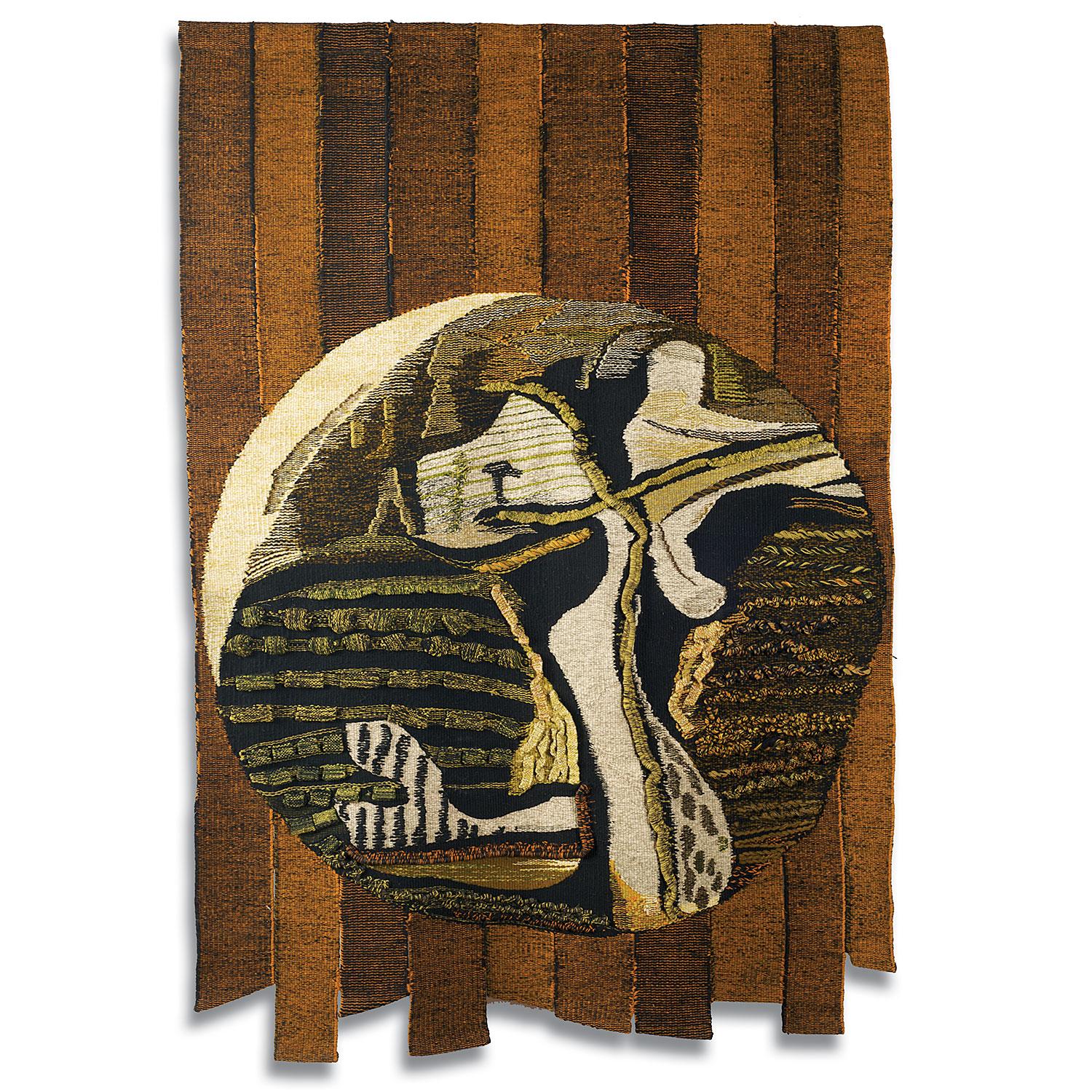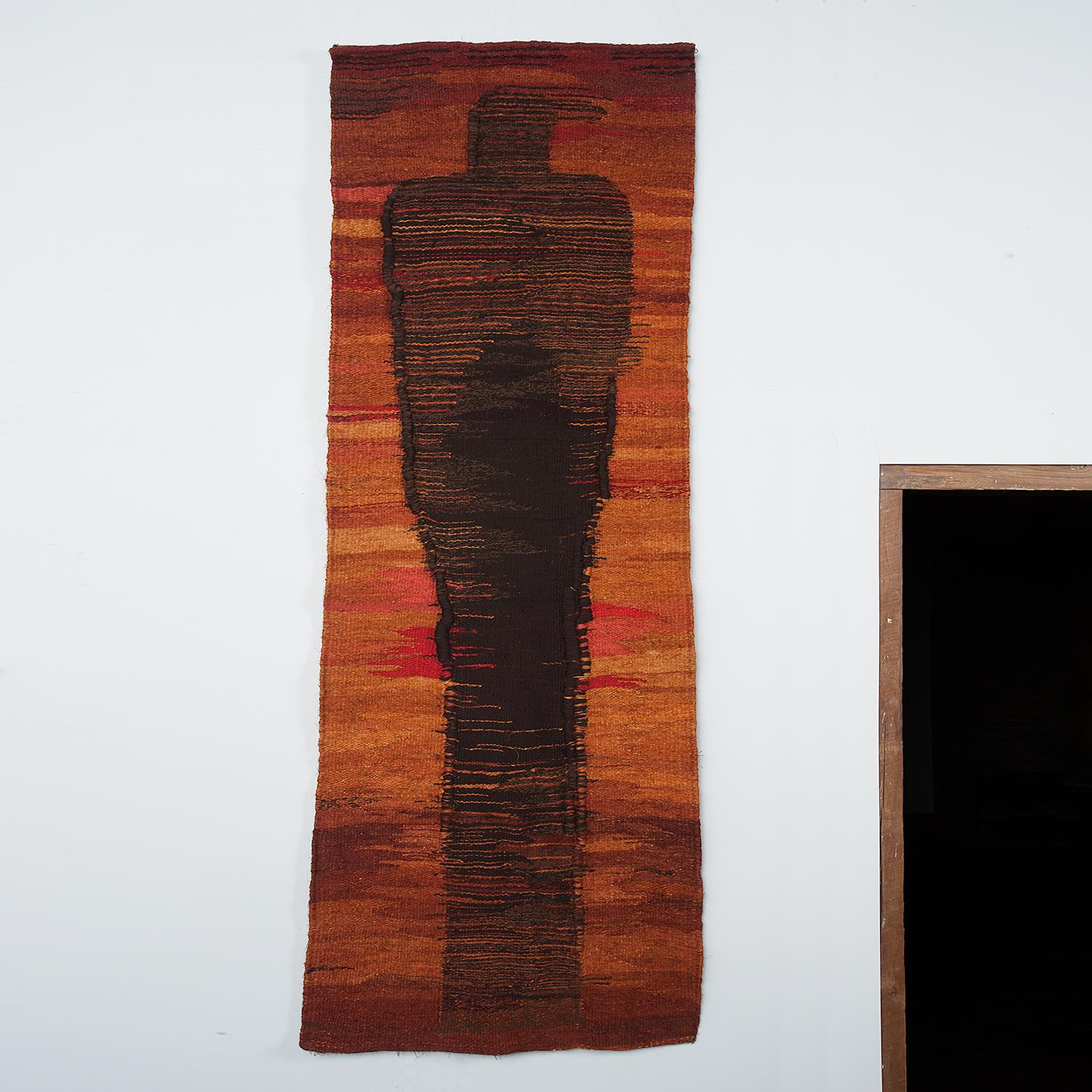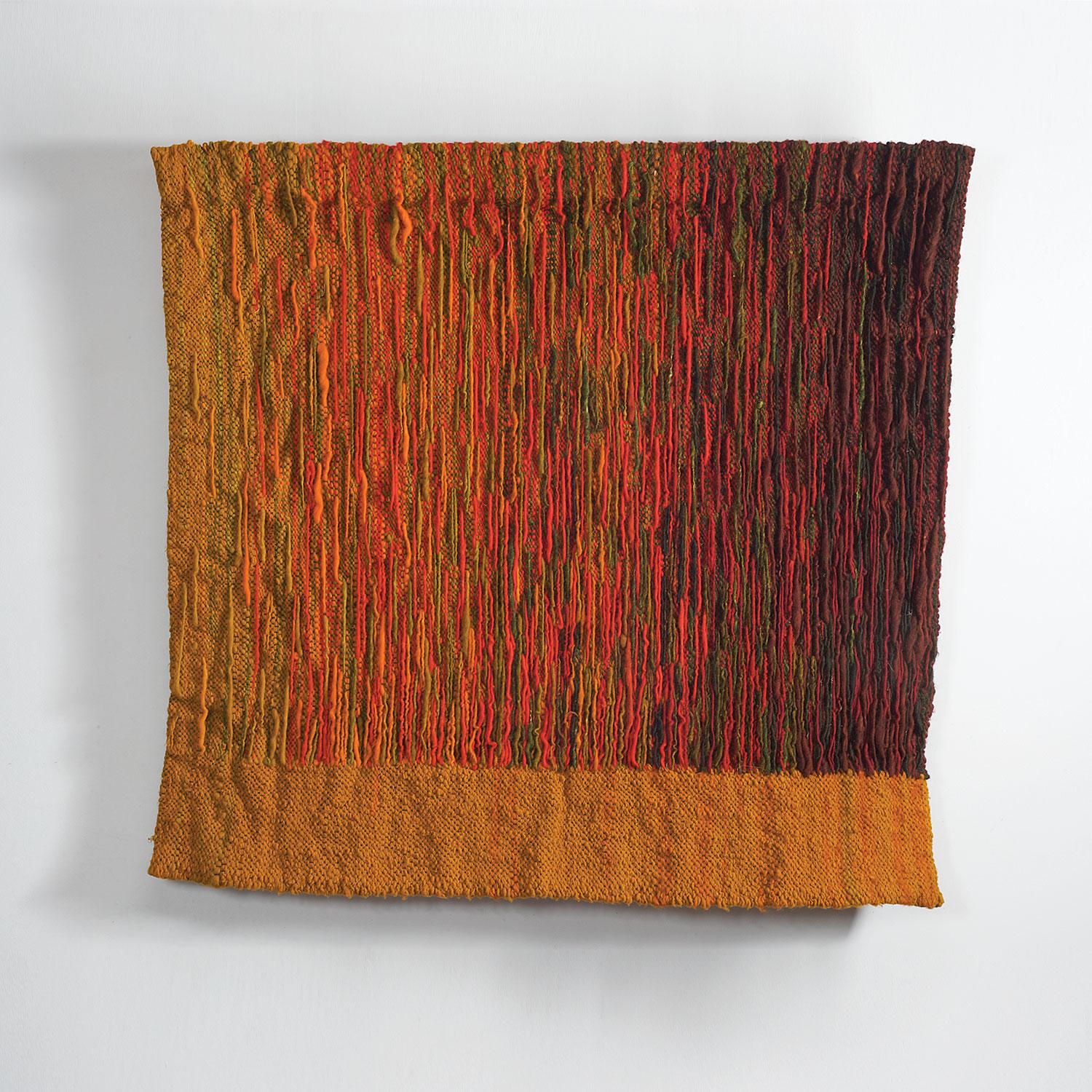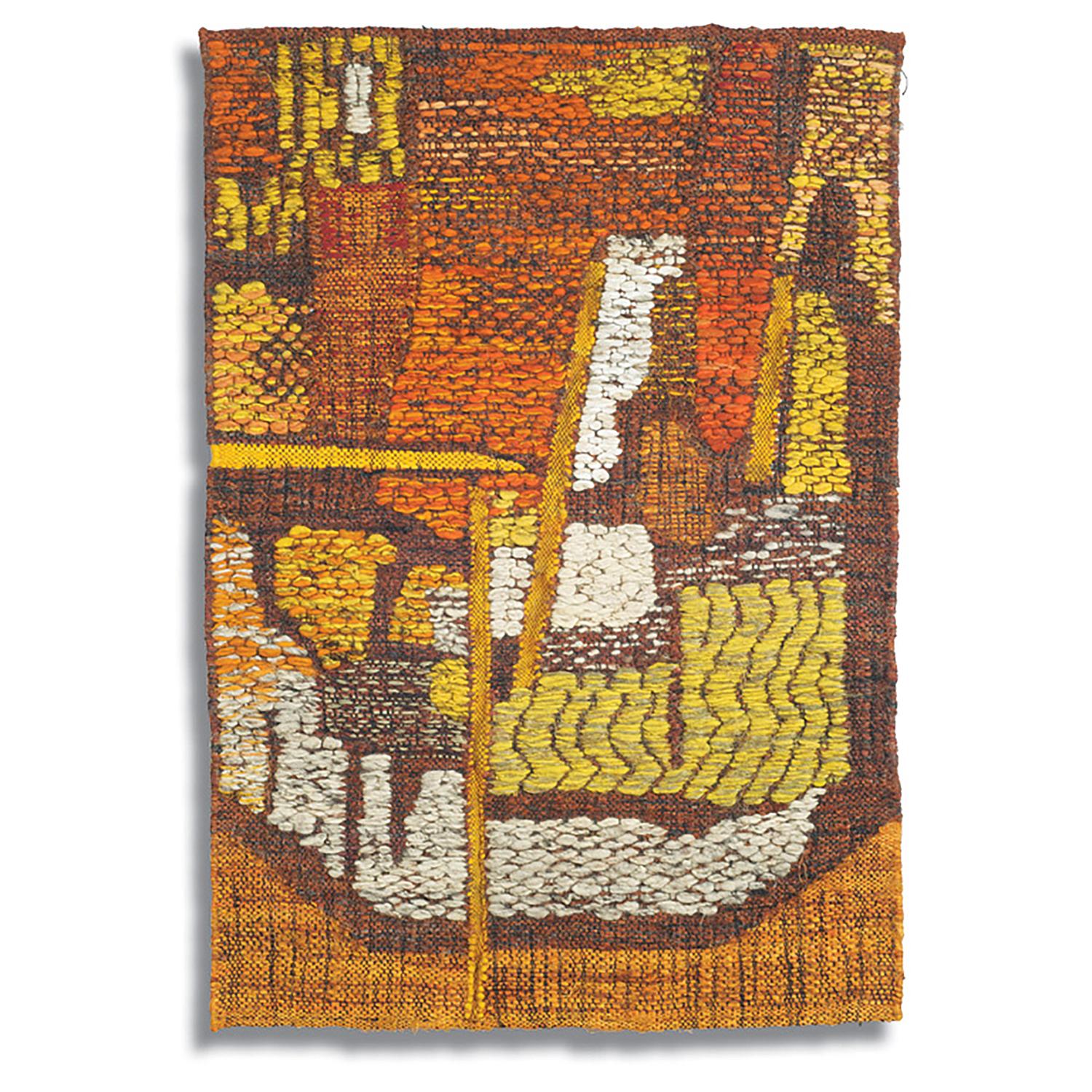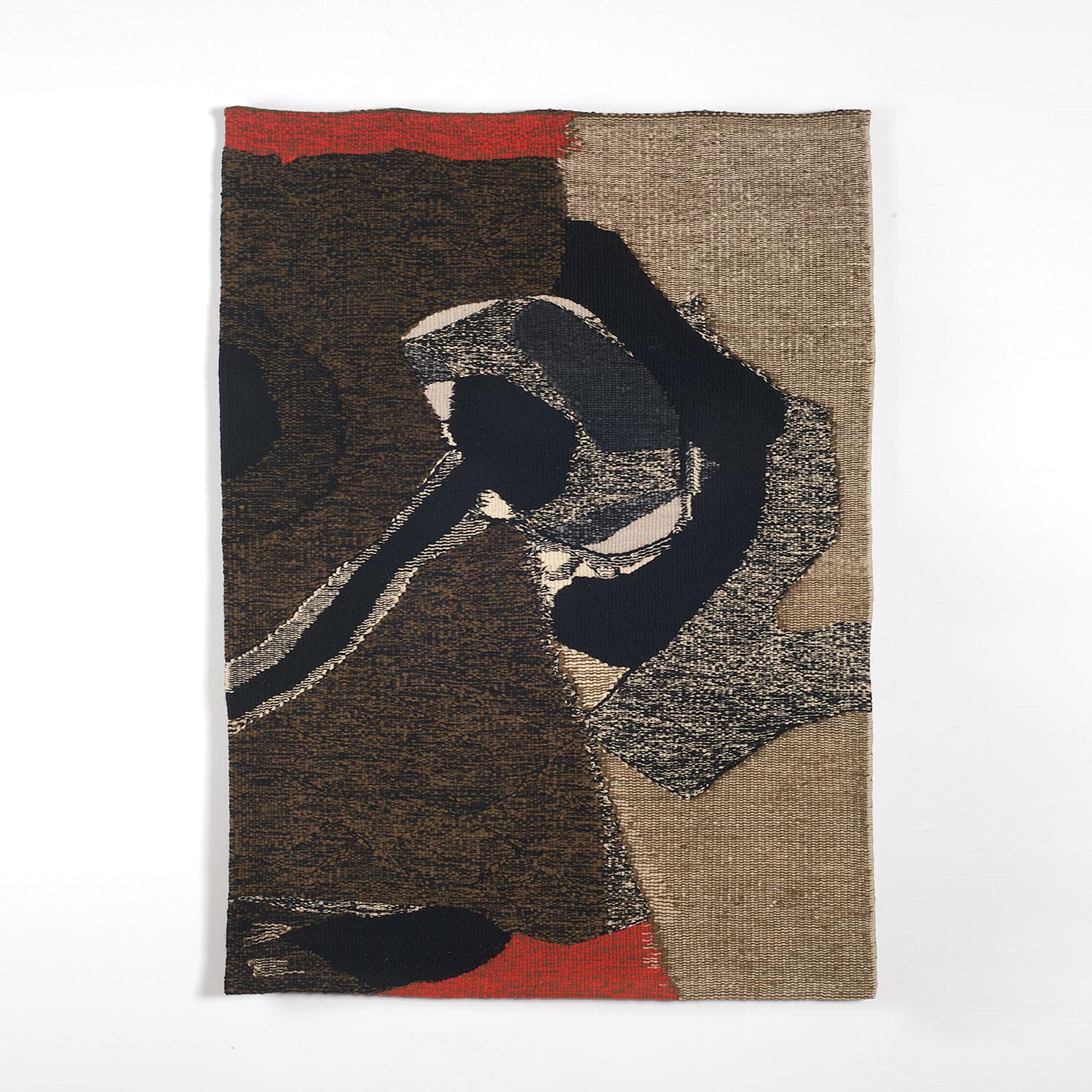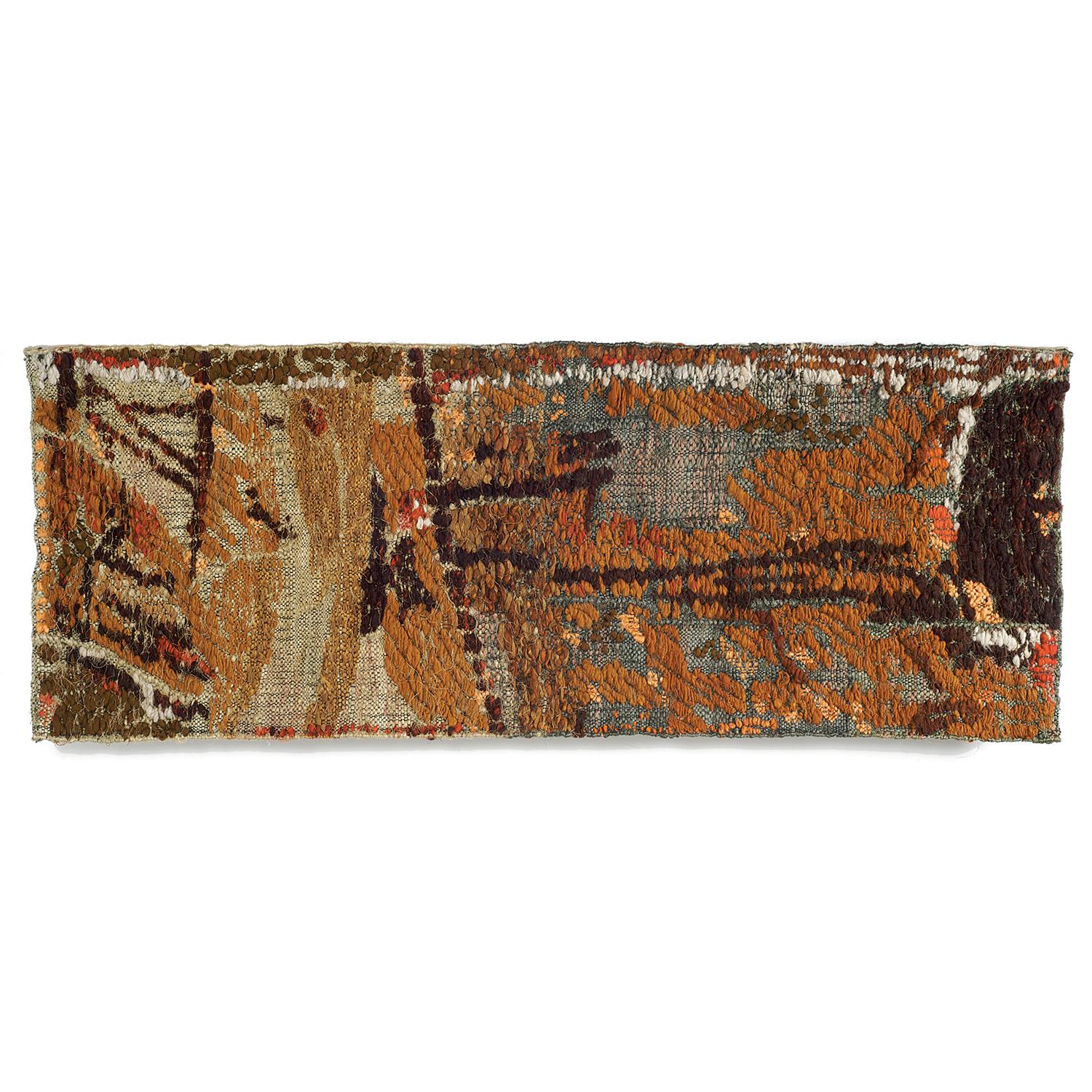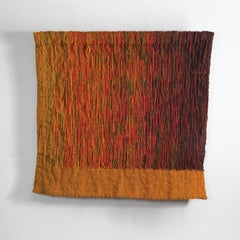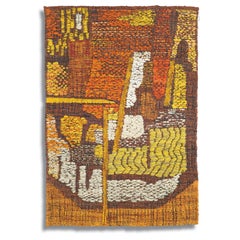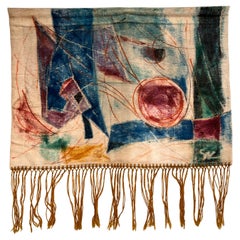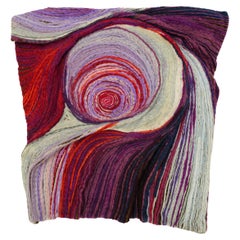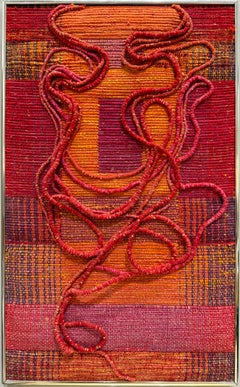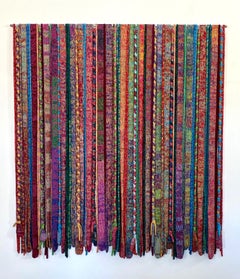Items Similar to Warp Ikat Spiral, Mid-Century Abstract Woven Tapestry, Textile Wall Sculpture
Want more images or videos?
Request additional images or videos from the seller
1 of 4
Ed RossbachWarp Ikat Spiral, Mid-Century Abstract Woven Tapestry, Textile Wall Sculpture1962
1962
$9,000
£6,783.47
€7,840.47
CA$12,716.95
A$13,900.09
CHF 7,320.84
MX$170,914.97
NOK 91,490.33
SEK 86,074.34
DKK 58,533.97
About the Item
Warp Ikat Spiral, weaving, 36"x108", 1962.
This mid-century geometric abstract tapestry was done by American textile artist, Ed Rossbach (1914-2002, Chicago, US). His career began in with ceramics and weaving in the 1940s, but evolved over the next decade into basket making. He is best known for his innovative and playful baskets made from nontraditional materials such as plastic and newspaper.
Artist Statement: “Well, I love all this mixture of things that people might interpret in various ways that I didn’t intend...I think it’s sort of amusing to have people misunderstand things and take things seriously that you mean not to be serious. Of course I don’t persuade myself that people think much about these things at all; I think they just sort of pass before their eyes. Maybe somebody will think a little bit about it, but I don’t think anybody is very concerned about what the meaning is of what I’m doing. I think it’s very unusual for people to look seriously at what someone else is offering as a work of art. You’re very much doing it for yourself. And I suppose that’s the essence of what I’m doing…."
- Creator:Ed Rossbach (1914 - 2002, American)
- Creation Year:1962
- Dimensions:Height: 36 in (91.44 cm)Width: 108 in (274.32 cm)Depth: 2 in (5.08 cm)
- Medium:
- Movement & Style:
- Period:
- Condition:
- Gallery Location:Wilton, CT
- Reference Number:Seller: 52r1stDibs: LU135926024792
Ed Rossbach
Ed Rossbach (1914-2002) completed his graduate studies at Cranbrook in 1946. He, along with Marianne Strengell worked within the narrow parameters of Euro-Bauhaus-Scandinavian weaving traditions for industry. “In reaction to this tight definition of textiles,” Jo Ann C. Stabb wrote in Retro/Prospective: 25+ Years of Art Textiles and Sculpture (vol. 37), “Rossbach became fascinated by indigenous textile processes and the use of found materials as he studied artifacts in the anthropology collection at University of California, Berkeley, as a faculty member from 1950 to 1979. Noted for creating three-dimensional, structural forms from unexpected, humble materials including plastic, reeds, newspaper, stapled cardboard, twigs, Rossbach inspired a renaissance in basketry and vessel forms and influenced other artists, including his students Gyöngy Laky and Lia Cook.” Rossbach began making baskets out of tundra grasses while stationed in the Aleutians during World War II, and went on to earn a Master of Fine Arts degree from Cranbrook Academy on the GI Bill. Like Pat Hickman and Lillian Elliott, he became part of the Bay Area fiber arts movement of the 1960s and 1970s, challenging traditional forms and media in basketmaking. He used plastic, metal, food cartons, and old newspapers to express his delight in American popular culture. A carefully crafted basket made out of trash was Rossbach's challenge to his audience to rediscover the joy of doing, of creating something of no value that was still beautiful.
About the Seller
5.0
Vetted Professional Seller
Every seller passes strict standards for authenticity and reliability
Established in 1987
1stDibs seller since 2020
17 sales on 1stDibs
Typical response time: <1 hour
- ShippingRetrieving quote...Shipping from: Wilton, CT
- Return Policy
Authenticity Guarantee
In the unlikely event there’s an issue with an item’s authenticity, contact us within 1 year for a full refund. DetailsMoney-Back Guarantee
If your item is not as described, is damaged in transit, or does not arrive, contact us within 7 days for a full refund. Details24-Hour Cancellation
You have a 24-hour grace period in which to reconsider your purchase, with no questions asked.Vetted Professional Sellers
Our world-class sellers must adhere to strict standards for service and quality, maintaining the integrity of our listings.Price-Match Guarantee
If you find that a seller listed the same item for a lower price elsewhere, we’ll match it.Trusted Global Delivery
Our best-in-class carrier network provides specialized shipping options worldwide, including custom delivery.More From This Seller
View AllCircle, Mid-Century Abstract Woven Tapestry, Textile Wall Sculpture
By Jan Hladik
Located in Wilton, CT
Circle, Mid-Century Abstract Woven Tapestry, Textile Wall Sculpture, Hand dyed wool, 87" x 63" (1976) by Czech textile artist, Jan Jladik, (192...
Category
Mid-20th Century Abstract Abstract Sculptures
Materials
Fabric, Textile, Tapestry, Wool, Dye
"Traces" Mid Century Woven Polish Tapestry, Figurative Textile Wall Sculpture
By Lilla Kulka
Located in Wilton, CT
Traces, sisal and hand spun wool, 108" x 42", 1979.
This large, figurative, mid-century modern tapestry was done by Polish textile artist, Lilla Kulka...
Category
1970s Abstract Abstract Sculptures
Materials
Fabric, Textile, Tapestry, Wool, Thread
Refleksy (Reflexes), Mid-Century Wool Tapestry, Abstract Textile Wall Sculpture
Located in Wilton, CT
Refleksy (Reflexes), flax (linen) and wool, 50" x 48" x 2", 1973.
This warm, vivid Mid-Century tapestry, Refleksy (1973) is by Polish textile artist, ...
Category
Mid-20th Century Abstract Abstract Sculptures
Materials
Fabric, Textile, Tapestry, Wool, Linen, Thread
Margaret VIII, Mid-Century Abstract Woven Tapestry, Textile Wall Sculpture
By Jolanta Owidzka
Located in Wilton, CT
Margaret VIII, flax, sisal and wool, 57" x 39", 1977.
This Mid-Century Modern abstract woven tapestry was done by Postwar and Contemporary Polish textile...
Category
Mid-20th Century Modern Abstract Sculptures
Materials
Fabric, Textile, Tapestry, Wool, Thread
Without Name, Mid-Century Abstract Woven Tapestry, Textile Wall Sculpture
By Jan Hladik
Located in Wilton, CT
Without Name, Mid-Century Abstract Woven Tapestry, Textile Wall Sculpture, Hand dyed wool, 52" x 38" (1973) by Czech textile artist, Jan Jladik...
Category
1970s Abstract Abstract Sculptures
Materials
Fabric, Textile, Tapestry, Wool, Dye
Stony Signs, Mid-Century Modern Abstract Woven Tapestry, Textile Wall Sculpture
By Jolanta Owidzka
Located in Wilton, CT
Stony Signs, wool, sisal, copper, 35" x 90", 1978.
This Mid-Century Modern abstract woven tapestry was done by Postwar and Contemporary Polish textile...
Category
Mid-20th Century Modern Abstract Sculptures
Materials
Metal, Copper
You May Also Like
1970s Abstract Design Hand made Wool Tapestry - Czechoslovakia
Located in Praha, CZ
- perfect original condition, bright colours
- marked
jr
Category
Vintage 1970s Czech Mid-Century Modern Tapestries
Materials
Wool
Fiber Art by Janet Kuemmerlein
By Janet Kuemmerlein
Located in Oklahoma City, OK
Janet Kuemmerlein's stunning fiber art piece, measuring 24”x 26”, is a captivating exploration of color and texture. With a mesmerizing palette ranging from vibrant purples to fiery ...
Category
Vintage 1970s American Mid-Century Modern Tapestries
Materials
Fabric, Yarn
Vintage Woven Textile Art Wall Sculpture After Sheila Hicks, Framed
By Sheila Hicks
Located in Miami, FL
Vintage Woven Textile Art Wall Sculpture After Sheila Hicks, Framed
Offered for sale is a vintage textile art wall hanging created after Sheila Hicks. This piece is expertly crafted...
Category
Vintage 1970s American Modern Wall-mounted Sculptures
Materials
Metal
"Carnival", Cotton Tapestry, Wall Hanging Sculpture, Thread, Textile, Polyester
By John Garrett
Located in St. Louis, MO
John Garrett was raised in southern New Mexico by parents who were both educators. They instilled in him an appreciation for the handmade with their collections of Native American a...
Category
2010s Contemporary Abstract Sculptures
Materials
Textile, Cotton, Thread, Polyester
Modern Abstract Tapestry Designed and Handwoven by Steve Chavez
By Steve Chavez
Located in New York, NY
Charming modern tapestry designed and handwoven by Steve Chavez (b. 20th Century, American). Attributed, titled and dated to fabric tag verso: Steve Chavez/ "The Elements"/Ribbon Series/ copyright 1989 S. Chavez/Jan '89
Provenance: "New Mexico Tapestry...
Category
Vintage 1980s American Modern Tapestries
Materials
Tapestry, Wool
"Desert Winterscape", Cotton Tapestry, Wall Hanging Sculpture, Thread, Textile
By John Garrett
Located in St. Louis, MO
John Garrett was raised in southern New Mexico by parents who were both educators. They instilled in him an appreciation for the handmade with their collections of Native American a...
Category
2010s Contemporary Sculptures
Materials
Textile, Cotton, Yarn, Polyester
More Ways To Browse
Mid Century Woven Wall Art
Mid Century Fabric Wall Art
Woven Fabric Art
Spiral Sculpture
Ikat Weavings
Friesian Horse
Fulton Fish
Game Bird Painting
General Custer
Geneva Vintage Poster
Girl At Piano
Giulio Romano
Grapevine Paintings
Hedda Sterne
Hockey Poster
Hong Kong Harbour
Horse Drinking Water
Hunt Slonem Yellow Bunny
